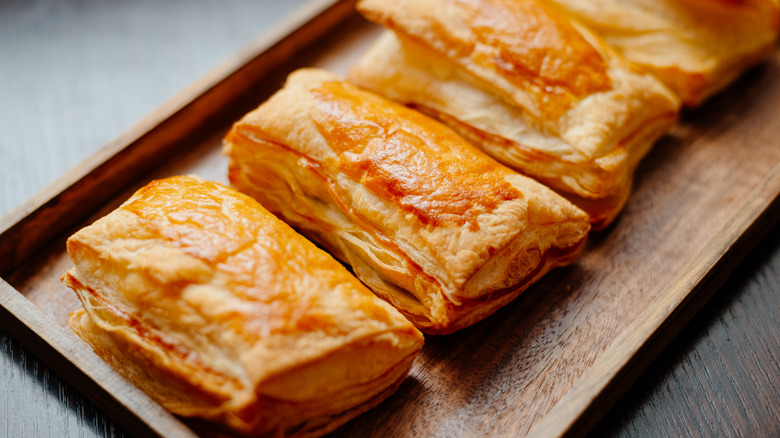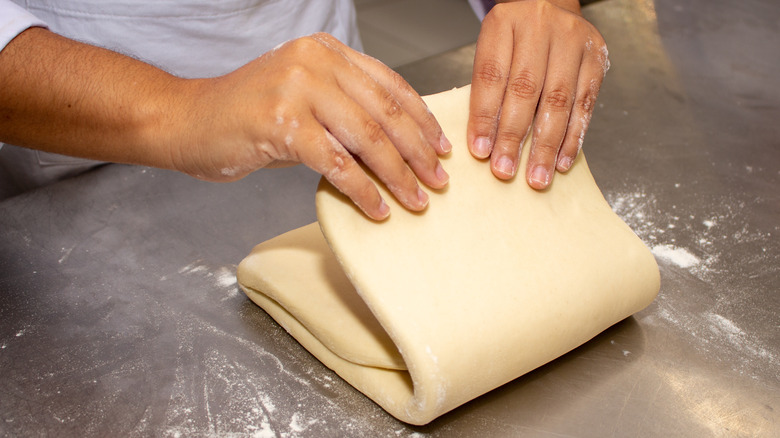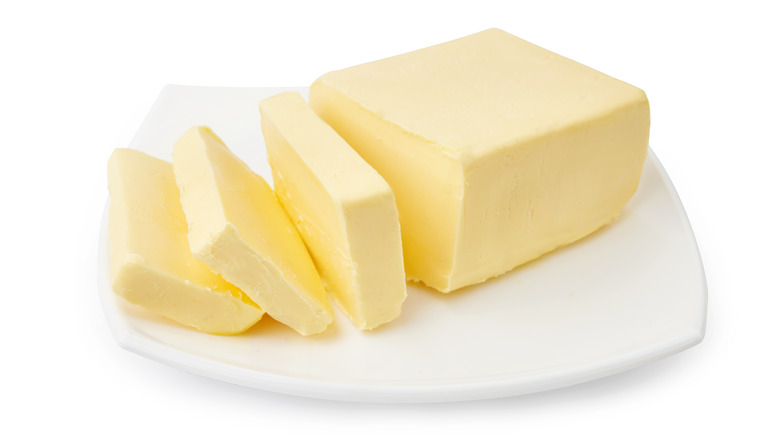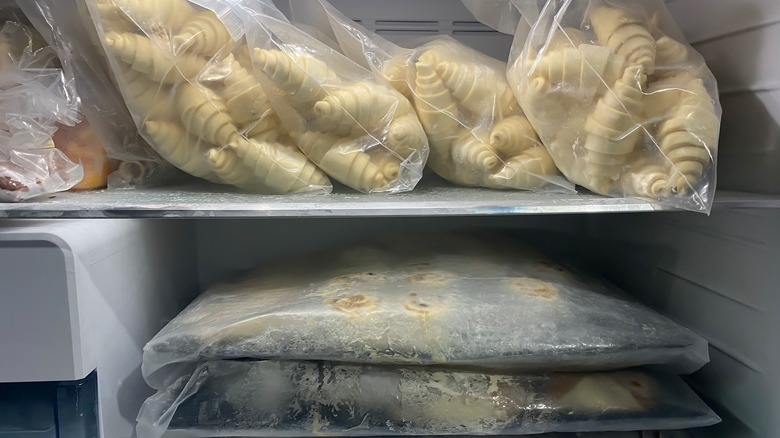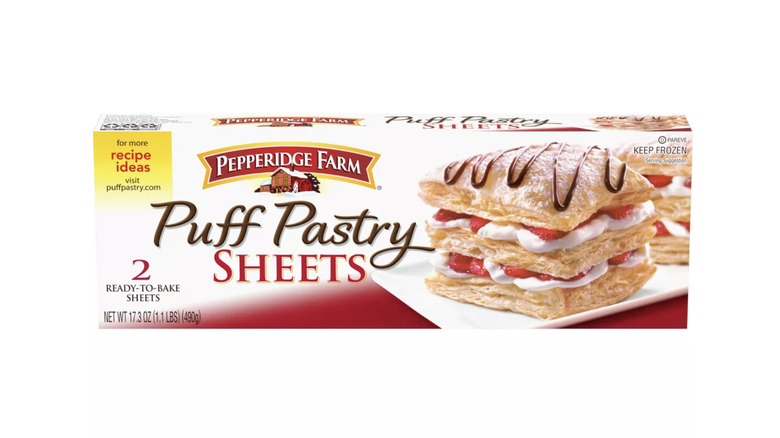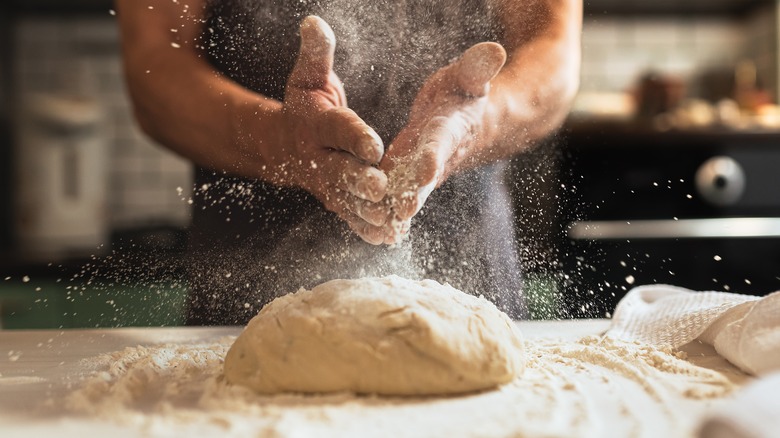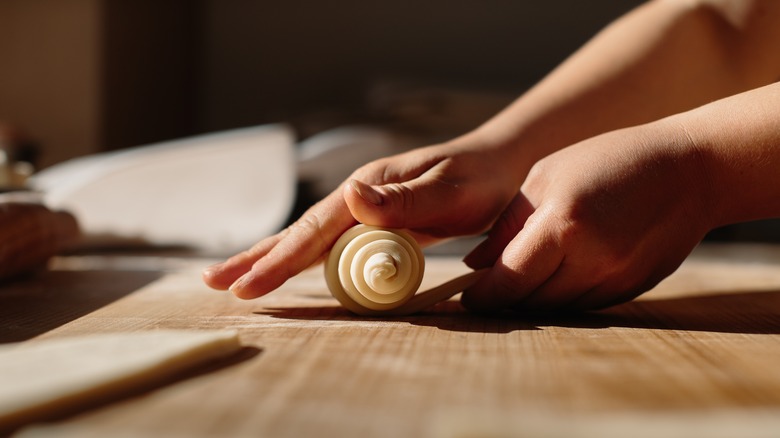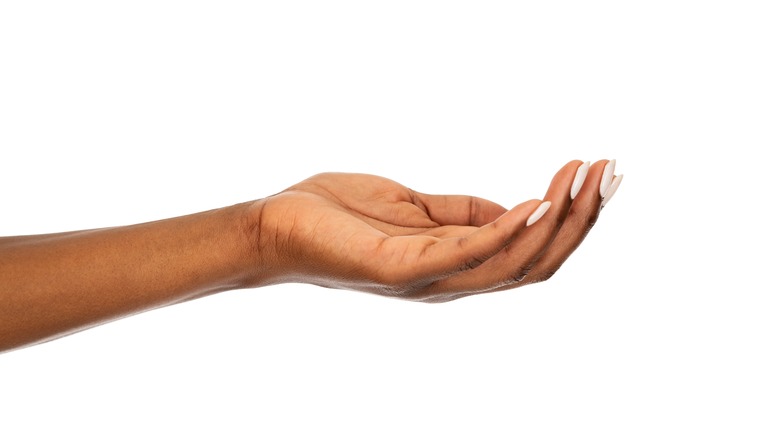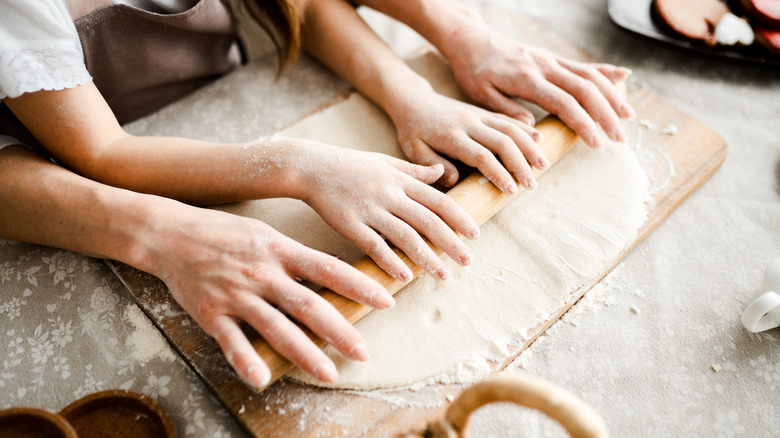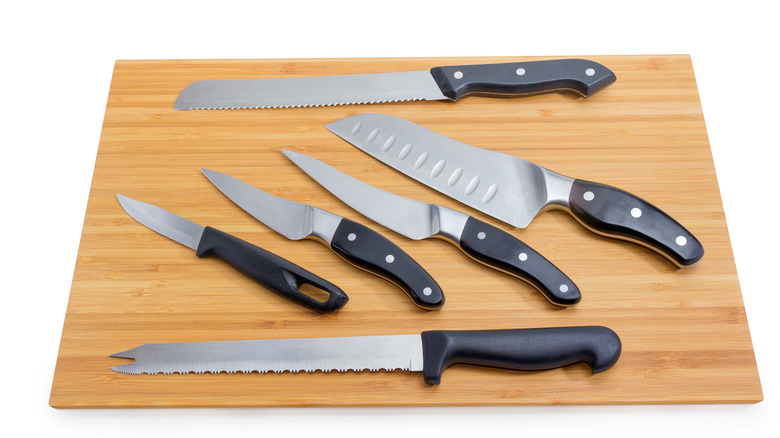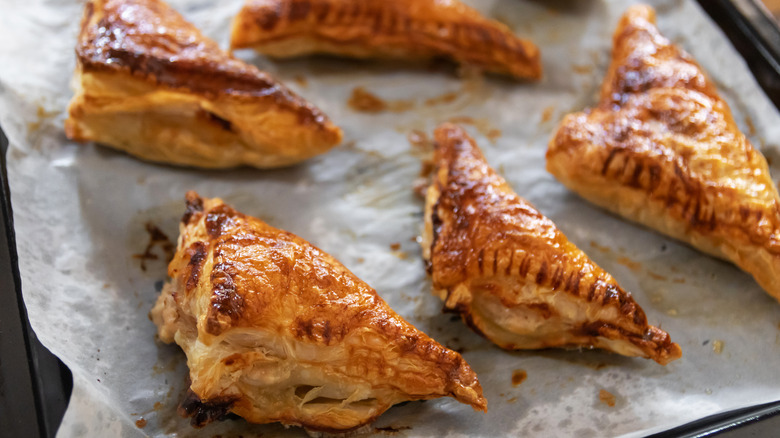Things You're Doing Wrong With Puff Pastries
Beneath its layers of flaky, buttery goodness, puff pastry is hiding secrets. This delicate baked good is notoriously difficult to master. Puff pastry is distinguished by its thin and crispy appearance that puffs up when baked, giving it a layered, flaky texture (via Bakerpedia). The pastry can be used as the basis for pies and tarts, as well as mixed with yeast to stand on its own as a croissant.
MasterClass explains that the dough gets its unique texture and appearance from a process called lamination. Functionally, it is dough being held together by butter and sheer will. While the dough is relatively simple in concept, a lot can go wrong when making puff pastry from scratch or when using premade frozen sheets. If your pastry is not puffing, fear not. We have compiled a list of things you may be doing wrong so that you can master this fickle dough.
Skimping on the folding
As mentioned, puff pastry is a type of laminated dough that is made by making layers of dough separated by butter or another fat. To achieve this, according to Bakerpedia, traditionally, a block of butter is sandwiched between two pieces of dough and then rolled out. This process is repeated several times, which creates thin pockets of fat between each layer that rise and give each layer definition.
As bakery owner and blogger for King Arthur Baking Company Andy King notes, folding and rolling truly turns the dough into puff pastry. After the initial roll of pastry and butter, the dough should be folded in thirds before being rolled out again. According to King, the process should be repeated at least three times, and this task becomes more challenging each time. This is because gluten forms, making the dough more elastic and more difficult to roll. However, it is vitally important that you roll out the dough to its full size according to the recipe you are using and that you do not forgo a fold because it is difficult. If you do, your dough will not be laminated, and you will not end up with the 81 layers to your pastry.
Using the wrong butter
The fat component of this dough is really the star here. Puff pastry dough is made with a lot of fat, so you do not want to use just any old butter if you make it at home. As Huffington Post explains, not all butter is created equal. Grocery stores often have multiple types for sale, and some are shockingly expensive.
But when it comes to such a butter-forward dish, as The City Bakery CEO Maury Rubin explains, it is worth the price. Higher quality products, such as European butter, have higher fat and lower water ratio than cheaper butter. This can mean a difference of 17% or 13% water. Using butter with more water in it can result in the wrong texture. While Rubin says it is not always necessary to splurge on higher-end butter, for baked goods that rely on the fat, such as puff pastry, it is worth the expense. Similarly, Andy King recommends using European butter of at least 83% fat when making the puff pastry-based croissant.
The butter should always be very cold as well. This helps ensure the pastry is flaky and golden brown once baked, per The Commons.
Not letting the dough chill
We all need to chill sometimes; puff pastry needs to chill all the time. When making your own puff pastry, Andy King states that the dough should be refrigerated between each roll and fold. Not only does this help relax the gluten bonds in the dough, making it easier to roll out, but it also helps to solidify the butter. He even goes so far as to recommend breaking the process into two days to allow for a more prolonged chill.
But puff pastry — the high-strung dough that it is — does not stop there. It needs to be cold when prior to handling, as well as during and after preparation. It does not matter if you make your own puff pastry or use a store-bought version from a brand such as Pepperidge Farm. The pastry needs to thaw and chill. Pepperidge Farm also recommends storing puff pastry in the refrigerator in between any given step, precisely cutting and shaping, and even using chilled tools.
Not thawing frozen puff pastry
This may seem like an obvious one but bear with us. We have all been there: You are running behind and dessert or breakfast needs to be made. Puff pastry from scratch is a long and arduous process to prepare, so you reach for the store-bought package that has been thawing in your fridge and find that it is still somewhat frozen. You decide that you are just going to try and use it. But physics can not be rushed.
As Pepperidge Farm notes, attempting to use the still-frozen puff pastry will result in the dough cracking and tearing. If the pastry dough is putting up resistance to folding and unfolding, it likely has yet to thaw enough for use. If you need the puff pastry to be useable quickly, it can thaw on the counter instead of in the fridge. Using this method, the pastry should be ready to handle in under 40 minutes. Alternatively, working one sheet at a time, microwave the puff pastry for 15 seconds on each side. If it is still frozen, microwave for an additional five seconds until fully thawed.
Not flouring your work surface
Flouring the work surface that you are making puff pastry on is vital at each step the pastry comes in contact with the work surface. If you are making puff pastry from scratch, during the initial lamination process, the work surface and the top of the dough should be lightly floured to prevent sticking (via King Arthur Baking). Just be sure not to overdo it, and brush any excess flour away before the next fold; too much flour can cause the layers to stick together and prevent lamination.
Once the dough is prepared, it is still important to keep the work surface lightly floured. Both Pepperidge Farm and General Mills recommend lightly flouring the work surface to prevent it from becoming tacky and having the dough stick to the surface. Once again, though, they recommend brushing away any excess flour, this time as it can prevent the dough from sticking together when you cut or fill it.
Letting the dough warm up
Any premature heat on the puff pastry prior to it going in the oven can be detrimental to the final outcome. So do not let the dough warm up. Pepperidge Farm takes keeping the dough cold very seriously. In addition to recommending the dough be thawed and stored in the fridge when not being used, they recommend using cold tools to keep the dough nice and chilly, such as chilled knives and bowls. They also suggest that if it is a particularly hot or humid day, you might just want to skip the puff pastry work altogether.
As General Mills explains, part of the need for cooling is due to the fact that if the dough becomes too warm, it will be challenging to work with. If it begins sticking to the work surface, it can quickly create a mess. But perhaps more importantly, allowing the dough to become too warm can cause the fat in the dough to "weep" out of it. This means less fatty goodness to the puff pastry. Additionally, melted fat can actually seal the pieces together, making the impact even worse — you won't get those flaky layers of goodness.
Being too handsy
It is never good to be too handsy, but for puff pastry, it can be detrimental. As demonstrated above, puff pastry does not like to be warm until it is placed in the oven. Unfortunately, being too hands-on with the dough can cause it to warm up and create all sorts of problems.
Pepperidge Farm recommends only handling puff pastry when it is cold, but it does not stop there. The brand goes so far as to tell users to wash their hands in cold water to prevent them from heating up the dough and recommends sticking their hands in bags of ice. While this may seem extreme, it highlights just how important keeping the dough cold is to the success of the pastry.
If sticking your hands in ice is not for you, the company also recommends using only your fingertips to handle the dough, as the fingers are the coolest part of the body. And if all else fails, pop your dough in the fridge and let it chill before working on it again.
Rolling the dough incorrectly
Once the pastry has been folded and left to chill in the refrigerator or a package of premade puff pastry dough has completely thawed, it is time to do the final roll. According to Pepperidge Farm, this roll-out helps to ensure that the dough is even and can be used appropriately. They caution, though, not to press too hard or roll over the edges of the dough, as this can cause the edges to smush together and the dough to seal. If this happens, it will not rise properly.
Additionally, General Mills warns that it is important to roll the dough out to the correct thickness. Puff pastry dough can rise eight times its original height, meaning at 1/4-inch-thick, the dough will rise up to 2 inches in height. Rolling the dough too thin though, can result in tears. Ensuring you use a proper rolling technique will produce a puff pastry that rises appropriately and holds together.
Using a dull blade
Once the puff pastry has been rolled out and layered, it is ready to be cut into whatever shape the recipe calls for. Again, it is important to pick the right tool for the job. A sharp blade is key to cutting through the dough easily and without sealing the layers of dough together (via Pepperidge Farm). The brand notes that a serrated knife gives the best cut — and cutting straight down into the dough is better than cutting at an angle, which can crimp the edges and seal the layers of dough together.
The brand also recommends using a specialty instrument called a pastry cutter for just this event. If you do not have one, a sharp pizza cutter or a cookie cutter are good alternatives. Just make sure your tool is very sharp, as no one wants to end up with a pastry with no puff.
Cooking on too-low heat
While puff pastry dough does not like the heat when it is being worked with, the opposite is true once it is time for baking. You might think that such a delicate pastry should be baked at a low heat, but that is not the case. As Pepperidge Farm notes, puff pastry needs that heat to rise. Therefore, they recommend preheating the oven for at least 15 to 20 minutes to ensure it reaches an even heat.
Puff Pastry also needs to cook at a relatively high heat to bake properly. While a common temperature for the oven is 350 degrees Fahrenheit, the pastry dough from Pepperidge Farm, for instance, bakes at 400 degrees Fahrenheit according to the box. Cookipedia has found that this is the standard temperature for baking puff pastry. The cafe The Commons explains that the heat is necessary to produce steam as the water in the butter evaporates and creates those beautiful crispy layers of puff pastry. Once the puff pastry is out of the oven and cooled, it is ready to be enjoyed!
